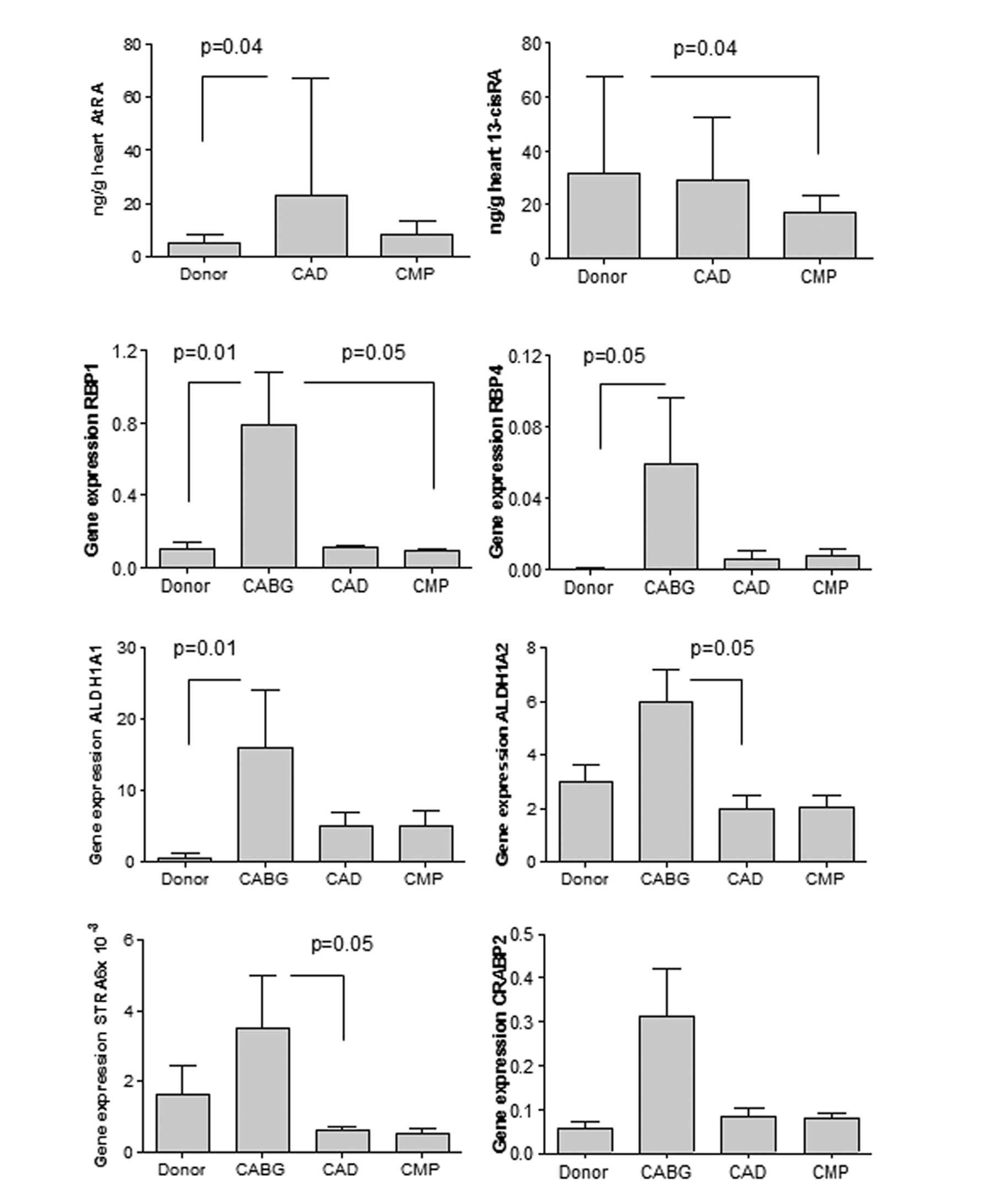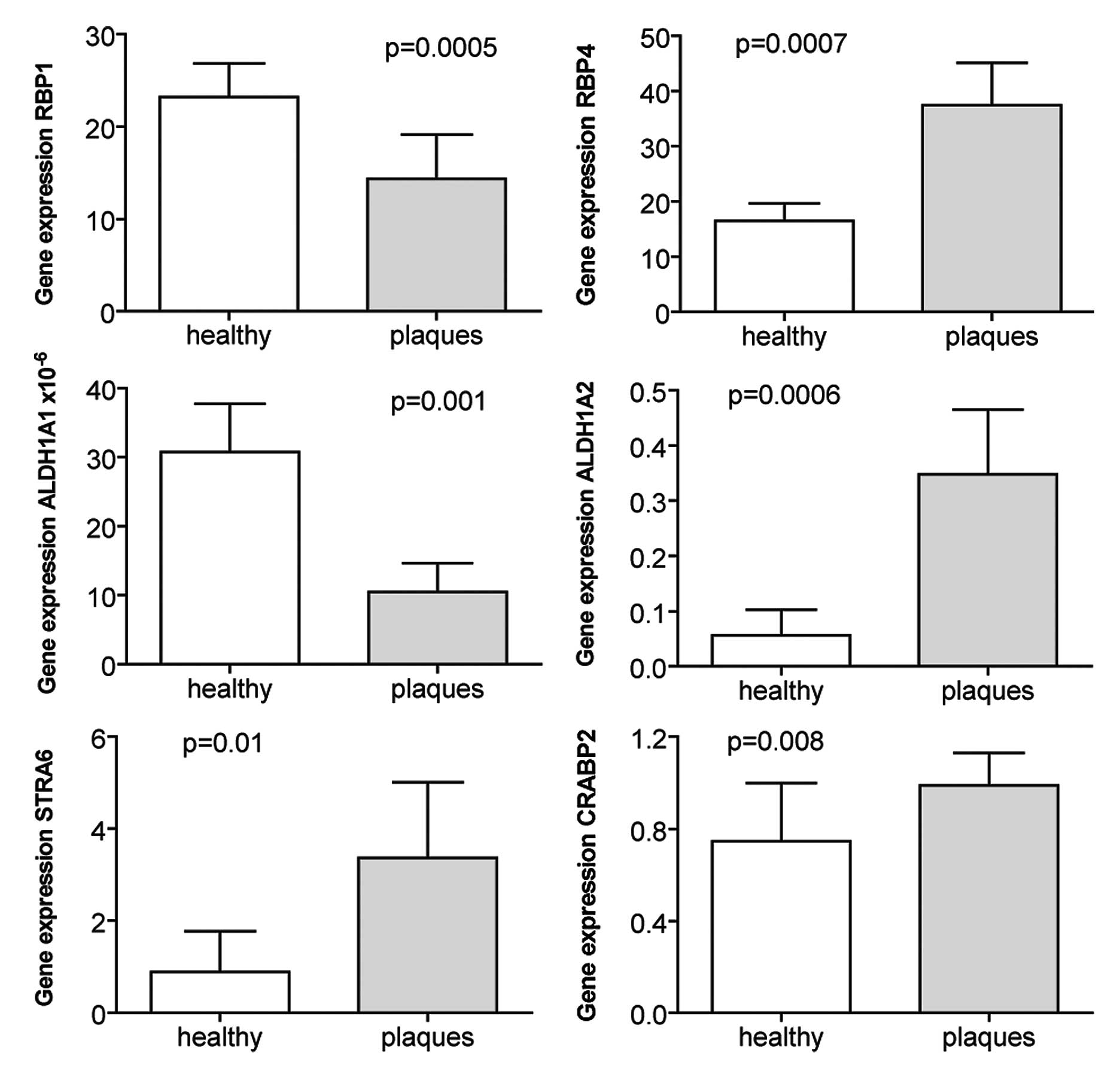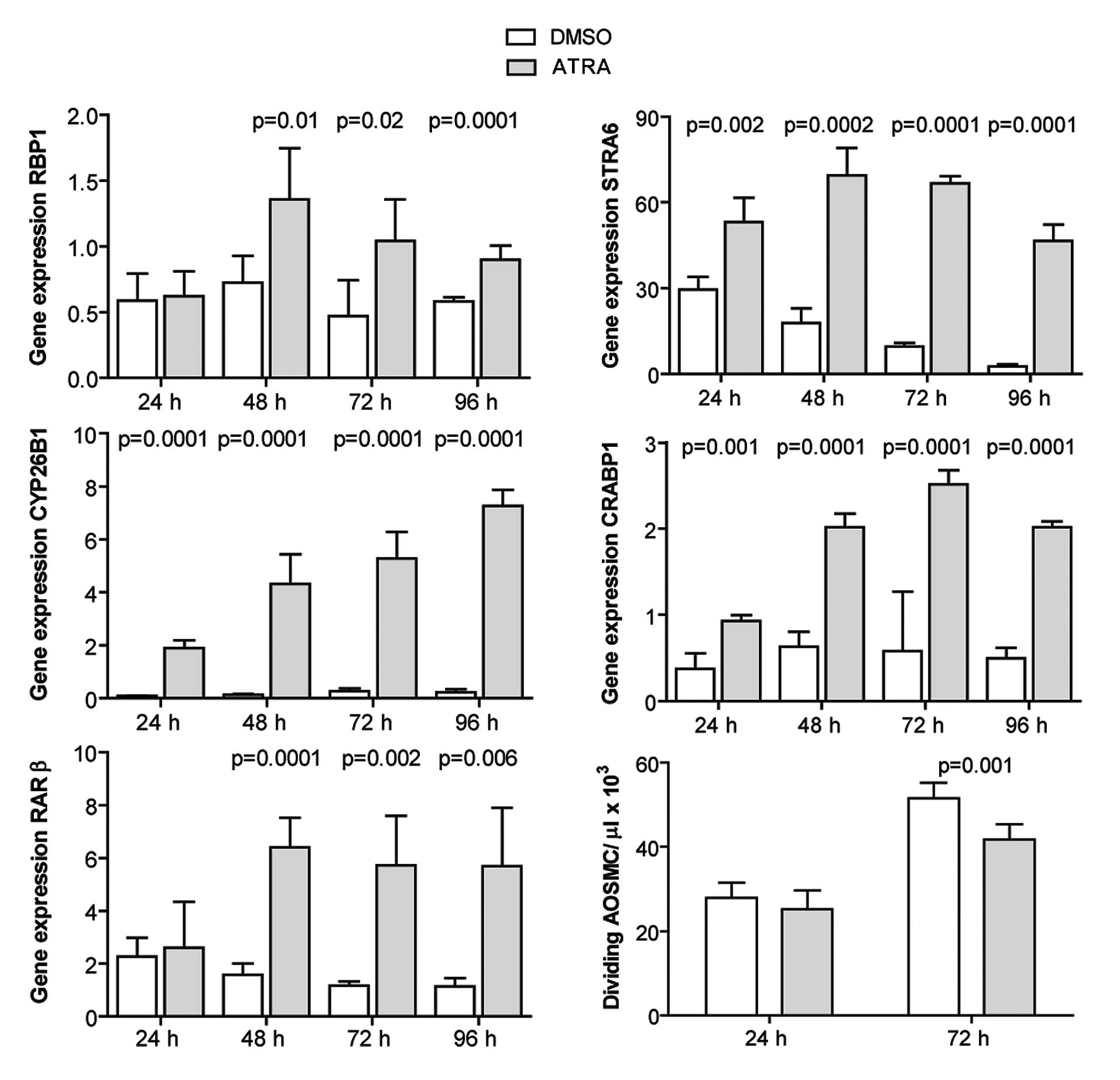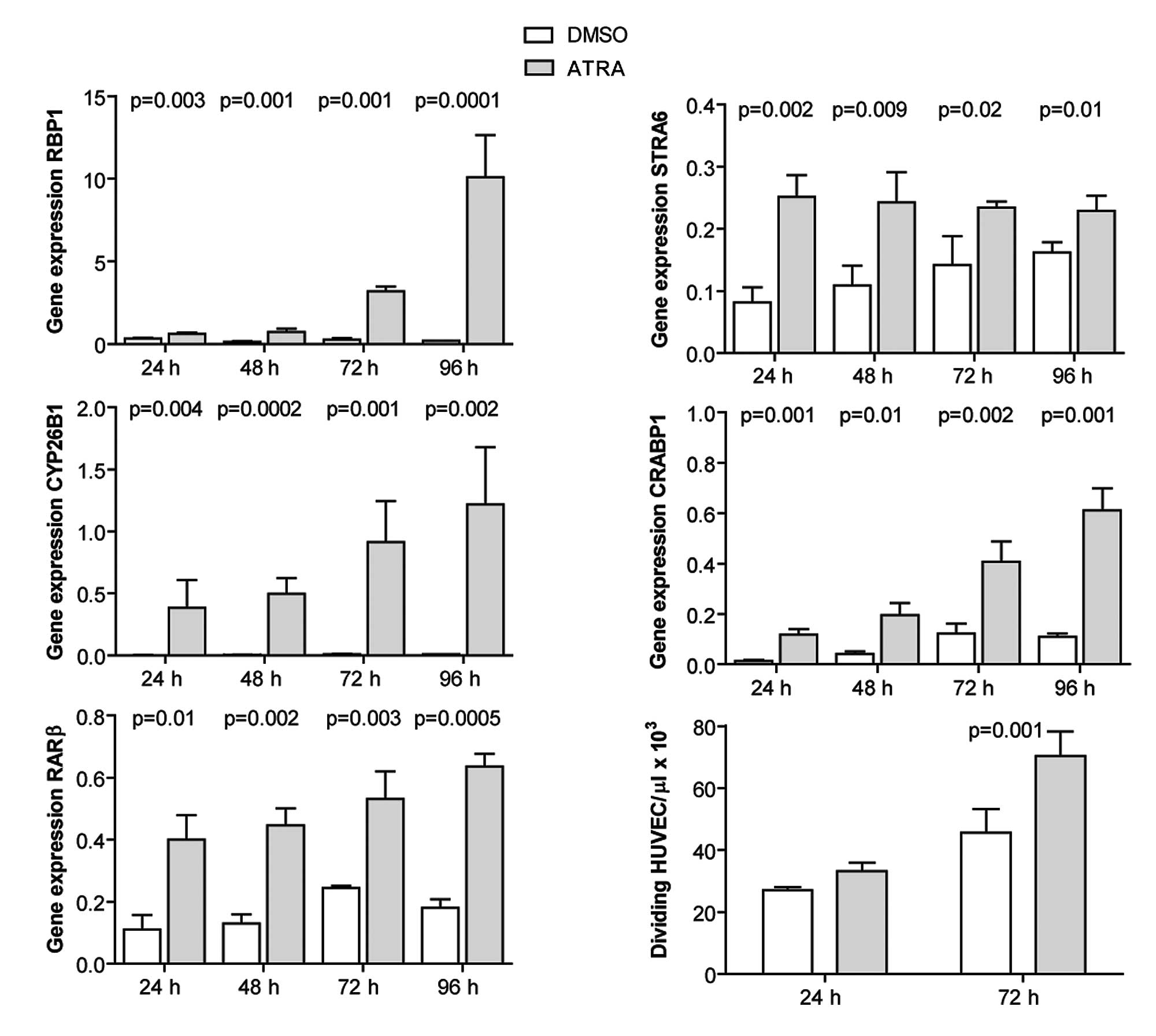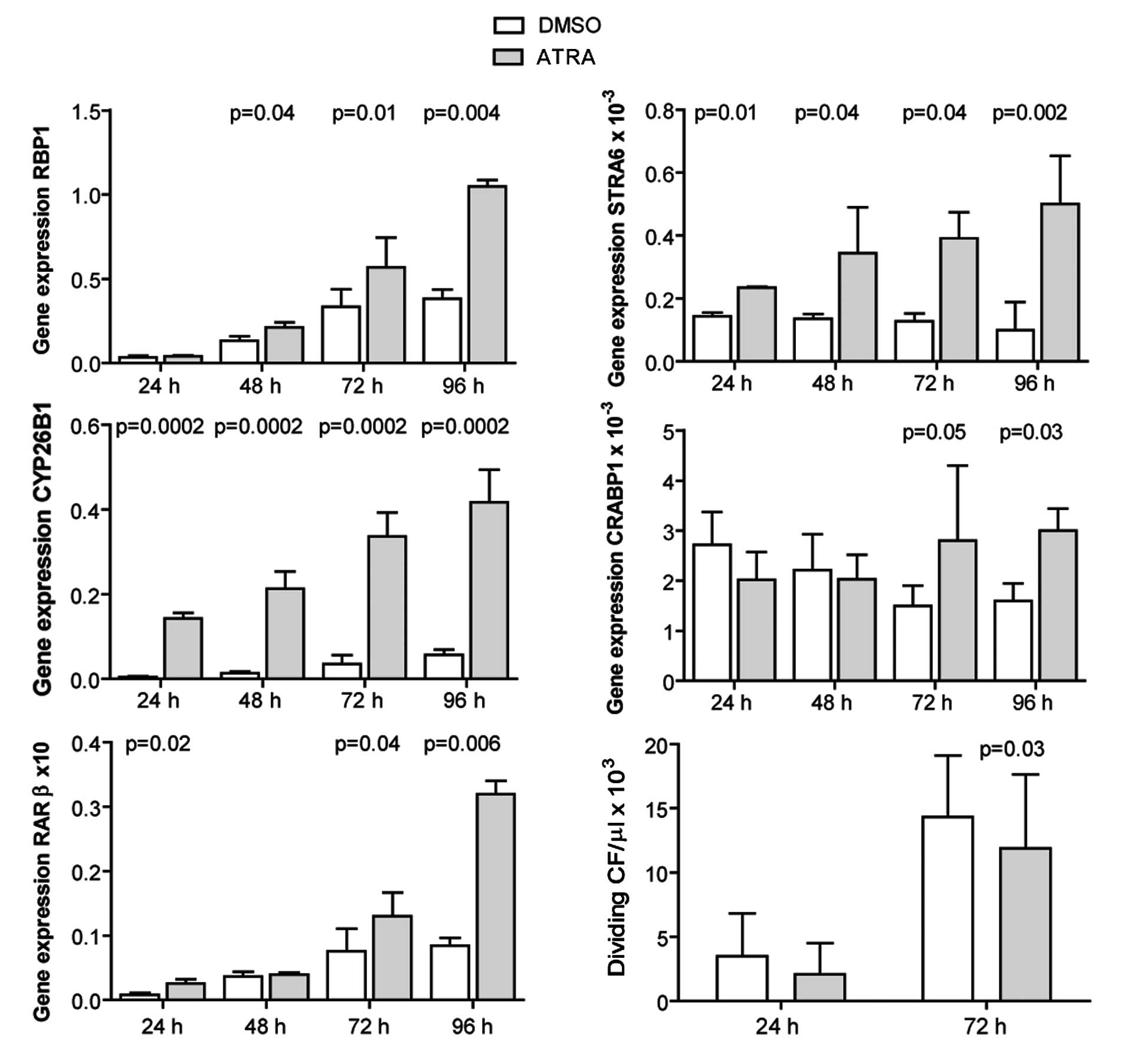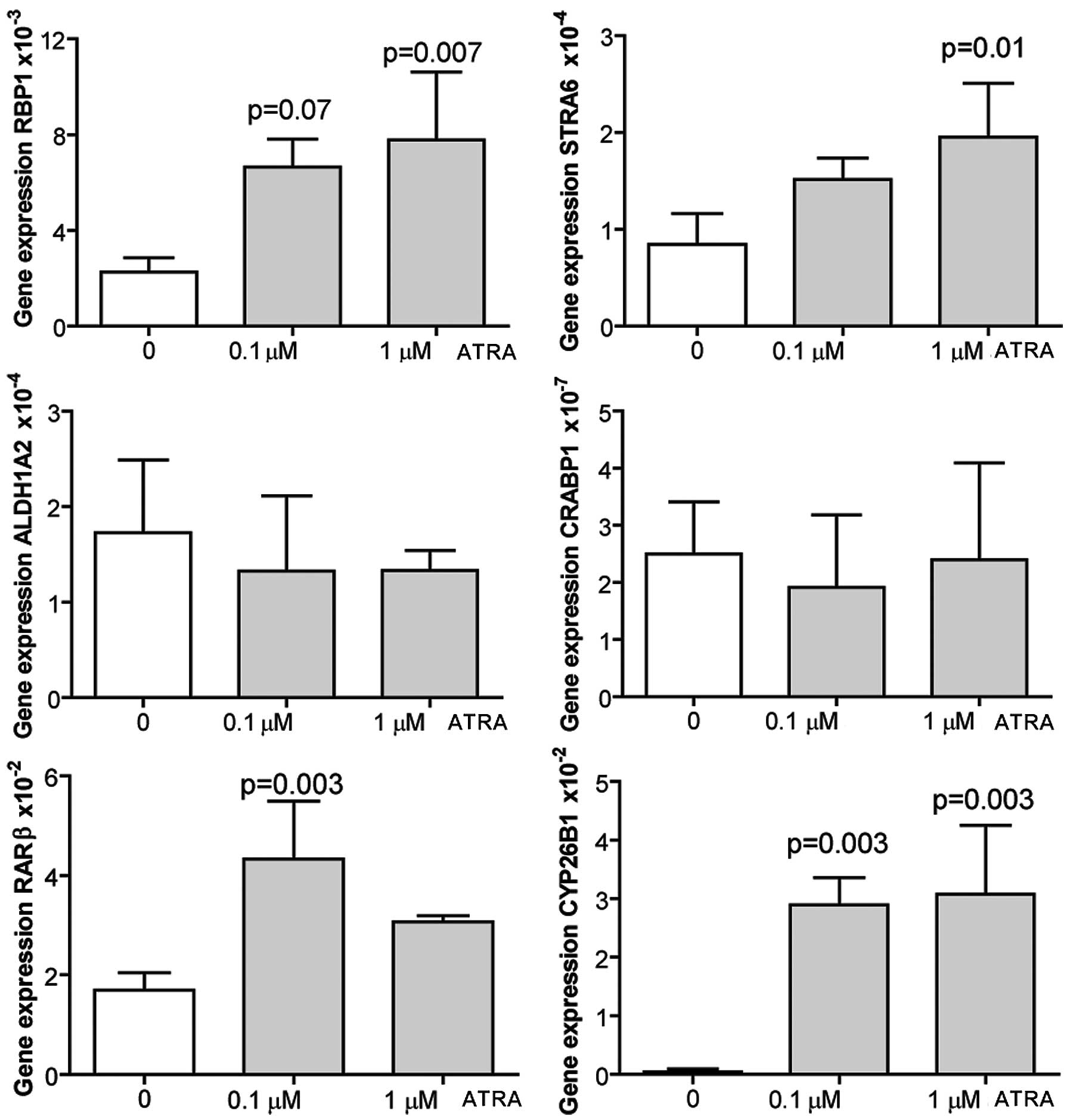Expression of retinoic acid target genes in coronary artery disease
- Authors:
- Published online on: January 13, 2014 https://doi.org/10.3892/ijmm.2014.1623
- Pages: 677-686
Abstract
Introduction
Coronary artery disease [(CAD), also known as atherosclerotic heart disease or ischemic heart disease] due to atherosclerosis of the coronary arteries is a major cause of mortality worldwide. The process of atherosclerosis involves chronic inflammation of the vessels (1). In response to endothelial injury, vascular smooth muscle cells and fibroblasts migrate and proliferate into the intima layer of the arterial wall (1). The progression of the disease involves the recruitment of immune cells from the circulation, as well as the deposition of blood lipids (1). In the vessel wall, the process may further involve the increased production of extracellular matrix (2). The latter is of particular importance in the process of plaque (lesion) destabilization, which may ultimately lead to the leakage of plaque debris into the circulation, the formation of thrombi and myocardial infarction (3). Post-infarction remodelling can then lead to heart failure (4). Heart failure represents a growing clinical challenge, possibly due to a steadily aging population and the improved treatment of patients with CAD, thus increasing their survival rate. The process of remodelling of the heart involves cardiomyocyte growth, cardiomyocyte death through apoptosis and autophagy, the deposition of extracellular matrix and the activation of fetal gene programs (5). Vascular and cardiac remodelling are distinct processes, but have a number of similarities. When evaluating how a new treatment regimen for CAD may influence cells (cellular remodelling), one could in parallel assess its effects on the vessel wall (vascular remodelling).
Retinoic acid (RA) metabolites are the active derivatives of vitamin A (retinol), exhibiting multiple effects on cell growth, differentiation and proliferation (6,7). RA metabolites have been shown to delay the development of atherosclerosis in ApoE-deficient mice, and prevent reocclusion following percutaneous coronary intervention (8). They have also been shown to modulate proliferative ability and promote reendothelialization following arterial injury (9,10). The improved understanding of the effects of RA on cells that are involved in different aspects of cardiovascular remodelling may lead to the identification of novel agents for the prevention and treatment of cardiac disorders. All-trans retinoic acid (ATRA) is used for the treatment of certain proliferative diseases, such as leukemia (10). It is appealing to clinically determine whether ATRA also shows antiproliferative properties in diseases of the cardiovascular system.
Vitamin A is stored in the liver and is transported to target cells bound to the plasma retinol binding protein (RBP). It enters the cells via the membrane receptor for plasma RBP, known as stimulated by retinoic acid gene 6 (STRA6). Intracellularly, retinol is converted to 9-cis retinoic acid (9cisRA), 13-cis retinoic acid (13cisRA), and ATRA in a two-step oxidative process. First, retinol is converted into retinal by retinol dehydrogenases (RDHs), and then retinal is converted into RA by retinal dehydrogenases (RALDHs or ALDHs). Synthesized RA binds to nuclear retinoic acid receptors (RARs) and retinoic X receptors (RXRs). Intracellular concentrations of RA metabolites are strictly regulated by the cytochrome P450 superfamily of enzymes (CYP26A1, CYP26B1 and CYP26C1), which convert ATRA into its hydroxylated inactive forms (11). Cellular retinol and RA binding proteins (CRBP and CRABP, respectively) deliver RA to the RARs (12,13).
While a great deal of progress has been made in identifying the stimuli that promote cell proliferation, the mechanisms that inhibit or suppress proliferative ability are less well characterized. Thus, the aim of this study was to investigate whether the RA metabolic pathway is activated in patients with CAD showing different levels of heart functionality, as well as in human atherosclerotic plaques. Furthermore, we examined the effects of ATRA on the expression of RA target genes and on the proliferation of endothelial cells, smooth muscle cells, cardiofibroblasts and cardiomyocytes.
Materials and methods
Ethics
All experiments were performed according to the Declaration of Helsinki, and the experiments were approved by the local ethics committee for animal and human research. Written informed consent was obtained from all patients or their family members prior to enrollment. The latter was the case when biopsies were obtained from explanted hearts of individuals who died from a cause not related to cardiac disease; the valves of these individuals were used for homograft preparations.
Human heart biopsies
Different sources of biopsy material were used for the measurement of RA metabolites and the expression of genes involved in RA metabolism and transport (RA target genes): i) A study performed at the National Hospital, Oslo, Norway, where biopsies of the left ventricular (LV) free wall were collected from still-beating explanted human hearts from patients with end-stage heart failure undergoing cardiac transplantation due to CAD (CAD group, n=9) or non-ischemic dilated cardiomyopathy (CMP group, n=15). The patients were classified as class IV based on the New York Heart Association (NYHA) functional classification system, with an LV ejection fraction of <35%. Donor hearts were obtained from gender- and age-matched healthy individuals with no history of heart disease (donor group, n=7). ii) A published study conducted at the Tampere University Hospital in Finland (14), where biopsies from the LV free wall were collected from patients undergoing elective coronary artery bypass grafting (CABG group, n=11). Tru-cut needle biopsies were performed following cannulation for extracorporeal circulation, but prior to cardioplegic arrest. The elective CABG patients had CAD associated with mild cardiac dysfunction and were classified as NYHA classes II–III, with an LV ejection fraction of >60%. From this study, material was sufficient for mRNA extraction, but not for the measurement of RA metabolites. Tissues were snap-frozen in liquid nitrogen, and stored at −80°C until use.
Human artery biopsies
In a third study performed at the Karolinska Institutet, Stockholm and at Örebro University, Örebro, Sweden, atherosclerotic plaques were collected from 9 patients during endarterectomy due to >80% carotid artery stenosis (15). Additional biopsies of non-sclerotic renal arteries were collected via nephrectomy on 5 patients who had no reported history of cardiovascular disease; this material was described in a previous study (15). Surgically-removed carotid and renal arteries were immediately rinsed in ice-cold sterile RNase-free phosphate-buffered saline (PBS) and transversely cut across the most prominent region. Three quarters of the specimen were instantly frozen on dry ice, to be later used for total RNA isolation. The remaining quarter was embedded and frozen in optimal cutting temperature (OCT) compound to be used for morphological confirmation of atherosclerosis using immunofluorescence (data not shown), and then frozen for RNA extraction, as previously described (16).
Measurement of RA metabolites
Human heart LV samples of CMP, CAD and healthy donors were homogenized in ice-cold PBS with a motorized homogenizer (Pro Scientific, Inc., Oxford, CT, USA). Retinoids were extracted from the homogenates by the addition of 2 volumes of ice-cold acetonitrile (10 ng/ml) containing ATRA (Sigma-Aldrich, St. Louis, MO, USA) labeled with 13C as an internal standard (IS). After vortexing for 10 min and centrifugation at 3,200 × g for 10 min, an aliquot of 75 ml was injected into a 4000 QTRAP liquid chromatography-mass spectrometry (LC-MS/MS) instrument with APCI ionization (Applied Biosystems, Foster City, CA, USA). The LC-MS/MS conditions were as described previously (17), except that the separating column was an ABZ Plus (Supelco/Sigma-Aldrich, Bellefonte, PA, USA) with a 75 by 3 mm inner diameter and 3-μm particles. The entire procedure was performed under red light. Calibration graphs were constructed by linear least-squares regression analysis, plotting peak area ratios of the analyte concentration and the IS against the corresponding concentrations. Quantification was carried out by interpolation and linear least-squares regression, as previously described (17).
Effects of RA on gene expression and proliferation of vascular cells
Human aortic smooth muscle cells (AOSMCs) were purchased from Cambrex Bio Science Walkersville, Inc. (Walkersville, MD, USA), while primary human umbilical vein endothelial cells (HUVECs) were purchased from Invitrogen (Stockholm, Sweden). AOSMCs from passages 4–8 and HUVECs from passages 3–7 were seeded in 12-well plates at a density of 2×104 cells/well. AOSMCs were cultured in supplemented human smooth muscle cell medium (M-231 with M-231–500; Cascade Biologics). HUVECs were cultured in VascuLife VEGF Medium (LL-0003; Lifeline Cell Technology). In order to investigate proliferation, cells were stimulated with 1 μM ATRA dissolved in DMSO or 1 μM DMSO alone for 24 and 72 h, trypsinized and counted by a haemocytometer (Burker). Counting was performed in triplicates of 5 independent experiments. Additionally, AOSMCs and HUVECs were seeded in 6-well plates at a density of 2×105 and stimulated with ATRA 1 μM or the vehicle alone (DMSO). Cells were harvested serially for total RNA extraction and the evaluation of expression of RA target genes by quantitative PCR after 24, 48, 72 and 96 h.
Isolation and culture of adult mouse cardiomyocytes and cardiofibroblasts
Adult mouse cardiomyocytes and cardiofibroblasts were isolated from hearts of C57BL6 mice using the method described by O’Connell et al (18). Hearts were explanted, cannulated through the aorta, purged of blood with perfusion buffer, and then perfused with digestion buffer containing collagenase II (Worthington Biochemical Corp., Lakewood, NJ, USA). Digested hearts were mechanically disrupted and suspended in perfusion buffer supplemented with 12.5 μM CaCl2 and 5% fetal calf serum (FCS). Cardiomyocytes were separated from cardiofibroblasts by serial centrifugations as previously described (18). Cardiofibroblasts were preserved in the supernatant from the first centrifugation and transferred to a separate tube for resuspension in Minimum Essential Medium (MEM) with Hank’s balanced salt solution (Gibco-BRL) and additives as previously described (19). Non-coated 6-well plates were plated equally with cell suspension. Cardiomyocytes were resuspended in MEM with Hank’s balanced salt solution with additives at 37°C in an atmosphere supplied with 2% CO2 for 24 h.
RA effects on gene expression and proliferation of cardiac cells
Cardiomyocytes and cardiofibroblasts were isolated from the hearts of 5 C57BL6 mice for the evaluation of RA target gene expression. Cardiofibroblasts were incubated up to 96 h in medium supplemented with 1 μM ATRA dissolved in ethanol. Control experiments were performed using medium supplemented with 1 μM ethanol only. Cells were harvested serially for total RNA extraction and the evaluation of the expression of RA target genes by quantitative PCR after 24, 48, 72 and 96 h. Cardiomyocytes were stimulated with 0,1 or 1 μM ATRA dissolved in ethanol or ethanol alone as the control. Cells were observed only for 24 h for gene expression evaluation, as these cells do not survive long once isolated and are not proliferative cells. Cells were harvested in 600 μl RLT buffer (Qiagen, Hilden, Germany), using a cell scraper, snap-frozen in liquid nitrogen, and stored at −80°C. Additional cardiofibroblasts were isolated from 4 C57BL6 mouse hearts. Cells were incubated up to 72 h in medium supplemented with 1 μM ATRA dissolved in ethanol (Sigma-Aldrich) and 10 μM 5-ethynyl-2′-deoxyuridine (EdU; nucleoside analogue to thymidine which is incorporated into DNA during active DNA synthesis). ATRA and EdU supplemented medium was changed every 24 h. Control experiments were performed using ethanol only. Cells were harvested for proliferation evaluation by EdU incorporation. Cardiofibroblast proliferation was determined using the Click-iT™ cell proliferation kit for flow cytometry following the manufactorers instructions (C-10418; Invitrogen). The events of 1,000 were analyzed using a LSR II flow cytometer (BD Biosciences). Pacific Blue™ was detected with logarithmic amplification using 406 nm excitation with violet (450/50 nm) emission filter. Side- and forward-scatter was monitored and used to exclude debris and doublets. Experiments were performed in duplicates from 4 independent isolations.
RNA isolation and cDNA synthesis
RNA was extracted using an RNeasy mini kit (Qiagen) with an additional phenol-chloroform extraction step and in-column DNase treatment (Qiagen). Random hexamers for priming (3 min at 70°C) were used for reverse transcription of 1 mg of RNA from whole heart extracts, carotid arteries lesion, normal kidney arteries, human aortic smooth muscle cells and human umbilical vein endothelial cells and 200 ng of RNA from isolated cardiomyocytes and cardiac fibroblasts. Reverse transcription was followed by a modified First Strand cDNA Synthesis Protocol with Superscript III (Invitrogen) and RNasin (Promega Corp., Madison, WI, USA) enzymes and cDNAs were amplified using quantitative PCR.
Quantitative polymerase chain reaction
RA target genes retinol binding protein 1 (RBP1), RBP2, RBP4, STRA6, aldehyde dehydrogenase 1 family, member A1 (ALDH1A1), ALDH1A2, cellular retinoic acid binding protein 1 (CRABP1), CRABP2, CYP26B1, RARα, RARβ and RARγ were amplified from human hearts and arterial biopsies, human aortic smooth muscle cells, human umbilical vein endothelial cells, and murine cardiomyocytes and cardiofibroblasts using real-time PCR. For amplification of human genes, predesigned primers and probes from Applied Biosystems were used (Table I). β-actin was used as an endogenous control for HUVECs, AOSMCs, and amplification of arterial RNA: β-actin forward, 5-CTG GCT GCT GAC CGA GG-3, reverse, 5-GAA GGT CTC AAA CAT GAT CTG GGT-3 and probe, 5-CCT GAA CCC CAA GGC CAA CCG-3. (TaqMan Gene Expression Assays; Applied Biosystems). For human heart material, hypoxanthine phosphoribosyl transferase (HPRT) was used as endogenous control. HPRT was purchased with ready-made primers and probe (assay ID 4310890E; Applied Biosystems). Mouse primers were designed with Primer Express 3.0 software and custom made by Eurofins on the basis of published cDNA sequences (primer sequences are available upon request) (Table II). SYBR-Green (Applied Biosystems) was used for detection. 18S rRNA predesigned Real-Time PCR primer and probe (Applied Biosystems; assay ID 4310893E) was used as endogenous control for mouse materials (20–22), while wells without cDNA were used as negative controls. PCR-amplification mixtures contained sample 2 μl cDNA, 10 μl of Power SYBR-Green PCR Master Mix (Applied Biosystems), and primers at a final concentration of 900 nM diluted with Milli-Q water in a total volume of 20 μl. The PCR reaction had the standard amplification scheme: one cycle of 2 min at 50°C (AmpErase UNG activation), one cycle of 10 min at 95°C (Gold AmpliTaq activation, AmpErase UNG inactivation), followed by 40 cycles of denaturation for 15 sec at 95°C and annealing/extension for 1 min at 60°C in a ABI 7900 HT Sequence Detection System (Applied Biosystems). Ct cycle values were correlated to a standard curve. The resulting mRNA levels relative to the 18S rRNA, HPRT, or β-actin were calculated according to the standard formula 2−ΔΔCt, where ΔΔCt = (CtTarget_sample−Ctendogenous control_sample) − (CtTarget_calibrator−Ctendogenous control_calibrator) (Applied Biosystems).
Statistical analysis
One-way analysis of variance (ANOVA) with Dunnett’s adjustment for multiple comparisons was used to evaluate RA metabolite measurements and gene expression in human hearts. The Student’s t-test was used to compare gene expression and cell proliferation data. Data are presented as the means ± SD. Differences were considered significant at P<0.05.
Results
Altered RA metabolism in human hearts with end-stage failure
Left ventricular biopsies of explanted human hearts collected during heart transplantation were homogenized for measurement of RA metabolites with LC-MS/MS. The ATRA concentration was significantly higher in the patients with end-stage heart failure due to CAD (CAD group) compared to the healthy donor hearts. 13cisRA expression was decreased in the hearts with non-ischemic dilated CMP (CMP group) compared to the healthy donor hearts (Fig. 1). Retinol and retinal levels were unaltered (data not shown). The samples from patients undergoing elective CABG (CABG group) were not sufficient for metabolite determination.
Increased cardiac expression of RA target genes in CAD
The expression of RA target genes was investigated in the LV biopsies of patients undergoing transplantation due to end-stage heart failure from CAD (CAD group) or due to CMP, as well as in biopsies obtained during open heart surgery with CABG (CABG group). Note that both groups of suffered from CAD, but patients in the CABG group had a good heart function with an ejection fraction >60%, as opposed to <35% in the CAD group. Hearts of the CABG group generally showed an elevated expression of genes coding for RA target enzymes, compared to the hearts of the CAD or CMP groups that came from patients classified in higher NYHA classes, or to healthy donor hearts. The expression of genes involved in the delivery of retinol into the cell (RBP1, RBP4 and STRA6), and that of genes involved in the transformation of intracellular retinol into the active forms of RA (ALDH1A1 and ALDH1A2) was significantly increased in patients undergoing CABG (p<0.05) compared to the other groups. The apparent increase of CRABP2 was not significant (Fig. 1).
Increased expression of RA target genes in atherosclerotic plaques
When the expression of the same genes was investigated in atherosclerotic plaques harvested from carotid arteries and compared to renal arteries without atherosclerosis, the expression of RBP4, STRA6, CRABP2 and ALDH1A2 was increased (Fig. 2). By contrast, the expression of RBP1 and ALDH1A1 was higher in the healthy renal arteries compared to the atherosclerotic plaques (Fig. 2).
ATRA induces the expression of RA target genes and inhibits the proliferation of human AOSMCs
AOSMCs were cultured and incubated with 1 μM ATRA for 24–96 h. The Expression of RA target genes was quantified with by qRT-PCR. ATRA induced the expression of the investigated genes at all time points, with a slightly different profile of induction observed for each gene (Fig. 3). Cell proliferation was evaluated at 24 and 72 h post-ATRA treatment by cell counting. ATRA inhibited the proliferation of AOSMCs at 72 h (Fig. 3).
ATRA induces the expression of RA target genes and promotes the proliferation of HUVECs
HUVECs were cultured and incubated with 1 μM ATRA for 24–96 h, and expression of RA target genes was quantified by qRT-PCR. ATRA induced the expression of the investigated genes at all time points (Fig. 4). Cell proliferation was evaluated at 24 and 72 h post-ATRA treatment by cell counting. ATRA promoted the proliferation of HUVECs at 72 h post-treatment (Fig. 4).
ATRA induces the expression of RA target genes and inhibits the proliferation of adult murine cardiofibroblasts
Cardiofibroblasts were isolated from adult mouse hearts, and incubated with 1 μM ATRA for 24–96 h. The expression of RA target genes was evaluated by qRT-PCR. ATRA induced the expression of the investigated genes, apart from CRABP1 at 24 and 48 h post-treatment (Fig. 5). Cell proliferation was evaluated at 24 and 72 h by measuring EdU incorporation. ATRA inhibited the proliferation of cardiofibroblasts (Fig. 5).
ATRA induces the expression of RA target genes in adult murine cardiomyocytes
Cardiomyocytes were isolated from adult mouse hearts, and were treated either with dissolvent alone (ethanol), or with 0.1 or 1 μM ATRA for 24 h prior to harvest. qRT-PCR of RA target genes revealed that ATRA induced the expression of RBP1, STRA6 and CYP26B1 in a dose-dependent manner. ALDH1A2 and CRBP1 expression was not affected by ATRA stimulation, while RARβ showed increased expression levels only after treatment with the lowest ATRA dose (Fig. 6). Cell proliferation was not examined.
Discussion
To our knowledge, this is the first study on the expression of endogenous metabolites and RA target genes in patients with CAD. Changes were observed in cardiac RA metabolites in patients with end-stage heart failure. The expression of RA target genes was clearly higher in patients with CAD undergoing CABG (CABG group) compared to patients with end-stage heart failure due to CAD (CAD group) or non-ischemic dilated CMP (CMP group), as well as in atherosclerotic plaques compared to healthy arteries. However, we could not obtain atherosclerotic plaques from the coronary arteries, and we did not have access to healthy carotid arteries for comparisons of gene expression in the same vascular bed. We hypothesized that the increased expression of RA target genes observed in the hearts of CABG patients may reflect tissue repair occurring in these patients where heart function is still good, compared to hearts of CAD or CMP patients, where the repair potential of the hearts is virtually non-existent.
The gene expression patterns observed in this study indicate increased RA signaling in CAD, with activation of genes involved in RA transport, uptake, conversion and delivery to nuclear receptors. The net effect of these changes may be the accumulation of RA derivatives. The hearts of patients of the CAD group showed an accumulation of ATRA, in contrast to those of the CMP group. The latter showed reduced levels of 13cisRA, a finding which is difficult to interpret. The cardiac cells in the hearts of CMP patients may be transformed from dilation to a degree that renders the comparison with other types of hearts of limited value. We were not able to measure RA metabolites in the hearts of CABG patients, since the biopsies obtained with a tru-cut needle were of insufficient size. Gene expression was examined instead. The upregulation of RBP1, RBP4 and STRA6 genes strongly indicates the increased activity of the RBP-STRA6 system, involved in physiological vitamin A uptake (23). The STRA6 protein, which is induced by RA metabolites, has previously been suggested to be a good predictor of the retinol cellular status (24). The increased expression of ALDH1A2 suggests the increased synthesis of biologically active forms of RA metabolites, while the increased expression of CRABP2 promotes the delivery of ATRA to the nucleus (25). In a model of permanent left coronary artery ligation in mice, we demonstrated that endogenous RA signaling is activated, concomitant with the accumulation of retinol in the heart during myocardial ischemia and remodelling (26). In this model, the intensity of gene expression and activity of RA response elements was most evident shortly after myocardial infarction, gradually decreasing over time. This pattern may be analogous to the increased expression of RA target genes in the CABG patients observed in the present study. CABG patients can be considered as a pathophysiological intermediate between normality and heart failure, and we speculate that their hearts undergo remodelling. In accordance with this hypothesis, another study demonstrated an accumulation of exogenously administrated RA in post-infarcted hearts of rats (27). The authors speculated that it would be beneficial to increase the antioxidant content in the ischemic hearts.
One of the beneficial roles of RA in myocardial ischemia may be mediated by the reduction in cardiofibroblast fibrosis, since treatment with ATRA reduced fibroblast proliferation in our study. Additional evidence for the role of RA in heart remodelling has been provided by other studies: rats with tissue insufficiency of vitamin A showed increased cardiac remodelling and increased ventricular dysfunction (27,28). Adverse LV remodelling was intensified when myocardial infarction was induced in rats with tissue vitamin A deficiency (28). In addition, the administration of RA to rats in a model of tobacco smoke-induced LV remodelling prevented adverse remodelling (29). RA administration also prevented remodelling induced by left coronary artery ligation (30). In our study, in the atherosclerotic plaques, we observed an increase in the expression of STRA6 and ALDH1A2 genes, suggesting an increased uptake of retinol and the synthesis of ATRA in the plaque. This could potentially delay plaque development, since we demonstrated that ATRA inhibited smooth muscle cell proliferation. In agreement with this result, we previously demonstrated that the increased catabolism of ATRA caused by a single nucleotide polymorphism (SNP) in the enzyme CYP26B1 is associated with larger atherosclerotic plaques (31).
Human hearts mainly contain cardiomyocytes, cardiofibroblasts, smooth muscle cells and endothelial cells. Thus, we investigated the effects of ATRA on these cell populations. The treatment of human smooth muscle cells with ATRA induced the expression of RBP1, STRA6, CYP26B1, CRABP1 and RARβ and inhibited cell proliferation at 72 h after treatment compared to time-matched control cells. These findings are in agreement with those of other studies, which reported that RA limits the proliferation of human coronary smooth muscle cells (6) and smooth muscle cells from the rat aorta (9). A number of studies have reported the beneficial effects of ATRA on intimal hyperplasia in models of arterial injury (6,9). ATRA signaling is tightly regulated by CYP26B1. siRNA-mediated silencing of the CYP26B1 gene and reduction of the enzymatic activity of CYP26B1 using the inhibitor, R115866, has been shown to increase ATRA-mediated signaling and to result in decreased smooth muscle cell proliferation (32).
In our study, the treatment of HUVECs with ATRA had similar effects on gene expression, but different biological effects. ATRA induced the proliferation of HUVECs, which is in accordance with observations made by others (33). In a previous study, in vivo, treatment with ATRA after balloon injury of the rat aorta increased reendothelialization, and enhanced endothelial-dependent relaxation of the injured aorta (34). Thus, RA metabolites may be important for endothelial recovery and the formation of new vessels.
When cardiofibroblasts and cardiomyocytes were treated with ATRA, the increase in gene expression was similar to that observed in endothelial and smooth muscle cells. The cardiomyocytes could only be studied in a short timeframe after treatment, since they do not survive long ex vivo. In the present study, the proliferative ability of cardiofibroblasts was inhibited by ATRA. We were unable to find similar studies performed by other research groups to assess the validity of this result. Notably, it was previously reported that ATRA inhibits angiotensin II-induced increase in cell growth and collagen secretion in neonatal cardiac fibroblasts (7). The effect of ATRA on fibroblast proliferation is assumed to be beneficial, since it may reduce the in vivo scar formation in post-infarcted tissue. The current therapy of CAD is based on the reduction of risk factors (by lowering triglycerides, increasing HDL, decreasing LDL, decreasing blood pressure or controlling hyperglycaemia), but not on the inhibition of the proliferative ability of cells involved in cardiovascular remodelling. The antiproliferative properties of ATRA are already used in clinical practice against acute promyelocytic leukemia and some forms of acute myeloid leukemia. The data from the present study suggest that due to its antiproliferative properties, ATRA may be used to delay remodelling, reduce restenosis, and preserve the functions of the cardiovascular system.
Acknowledgements
Torun Flatebø and Stian Weiseth are gratefully acknowledged for their excellent work. This study was supported by grants from the Novo Nordisk Foundation, the Norwegian Health Association, The Center for Heart Failure Research and the University of Oslo.
References
|
Hansson GK and Hermansson A: The immune system in atherosclerosis. Nat Immunol. 12:204–212. 2011. View Article : Google Scholar : PubMed/NCBI | |
|
Tyagi SC, Meyer L, Schmaltz RA, Reddy HK and Voelker DJ: Proteinases and restenosis in the human coronary artery: extracellular matrix production exceeds the expression of proteolytic activity. Atherosclerosis. 116:43–57. 1995. View Article : Google Scholar : PubMed/NCBI | |
|
Fishbein MC: The vulnerable and unstable atherosclerotic plaque. Cardiovasc Pathol. 19:6–11. 2010. View Article : Google Scholar : PubMed/NCBI | |
|
McKay RG, Pfeffer MA, Pasternak RC, Markis JE, Come PC, Nakao S, et al: Left ventricular remodeling after myocardial infarction: a corollary to infarct expansion. Circulation. 74:693–702. 1986. View Article : Google Scholar : PubMed/NCBI | |
|
Valen G: Innate immunity and remodelling. Heart Fail Rev. 16:71–78. 2011. View Article : Google Scholar : PubMed/NCBI | |
|
Wakino S, Kintscher U, Kim S, Jackson S, Yin F, Nagpal S, Chandraratna RA, Hsueh WA and Law RE: Retinoids inhibit proliferation of human coronary smooth muscle cells by modulating cell cycle regulators. Arterioscler Thromb Vasc Biol. 21:746–751. 2001. View Article : Google Scholar : PubMed/NCBI | |
|
He Y, Huang Y, Zhou L, Lu LM, Zhu YC and Yao T: All-trans retinoic acid inhibited angiotensin II-induced increase in cell growth and collagen secretion of neonatal cardiac fibroblasts. Acta Pharmacol Sin. 27:423–429. 2006. | |
|
Gidlof AC, Ocaya P, Krivospitskaya O and Sirsjo A: Vitamin A: a drug for prevention of restenosis/reocclusion after percutaneous coronary intervention? Clin Sci (Lond). 114:19–25. 2008. View Article : Google Scholar : PubMed/NCBI | |
|
Miano JM, Kelly LA, Artacho CA, Nuckolls TA, Piantedosi R and Blaner WS: All-trans-retinoic acid reduces neointimal formation and promotes favorable geometric remodeling of the rat carotid artery after balloon withdrawal injury. Circulation. 98:1219–1227. 1998. | |
|
Lee CW, Park SJ, Park SW, Kim JJ, Hong MK and Song JK: All-trans-retinoic acid attenuates neointima formation with acceleration of reendothelialization in balloon-injured rat aorta. J Korean Med Sci. 15:31–36. 2000. | |
|
Fujii H, Sato T, Kaneko S, Gotoh O, Fujii-Kuriyama Y, Osawa K, Kato S and Hamada H: Metabolic inactivation of retinoic acid by a novel P450 differentially expressed in developing mouse embryos. EMBO J. 16:4163–4173. 1997. View Article : Google Scholar : PubMed/NCBI | |
|
Dong D, Ruuska SE, Levinthal DJ and Noy N: Distinct roles for cellular retinoic acid-binding proteins I and II in regulating signaling by retinoic acid. J Biol Chem. 274:23695–23698. 1999. View Article : Google Scholar : PubMed/NCBI | |
|
Blomhoff R, Green MH, Berg T and Norum KR: Transport and storage of vitamin A. Science. 250:399–404. 1990. View Article : Google Scholar | |
|
Czibik G, Wu Z, Berne GP, Tarkka M, Vaage J, Laurikka J, Järvinen O and Valen G: Human adaptation to ischemia by preconditioning or unstable angina: involvement of nuclear factor kappa B, but not hypoxia-inducible factor 1 alpha in the heart. Eur J Cardiothorac Surg. 34:976–984. 2008. View Article : Google Scholar : PubMed/NCBI | |
|
Olofsson PS, Sheikine Y, Jatta K, Ghaderi M, Samnegard A, Eriksson P and Sirsjö A: A functional interleukin-1 receptor antagonist polymorphism influences atherosclerosis development. The interleukin-1beta:interleukin-1 receptor antagonist balance in atherosclerosis. Circ J. 73:1531–1536. 2009. View Article : Google Scholar | |
|
Olofsson PS, Söderström LA, Jern C, Sirsjö A, Ria M, Sundler E, de Faire U, Wiklund PG, Ohrvik J, Hedin U, Paulsson-Berne G, Hamsten A, Eriksson P and Hansson GK: Genetic variants of TNFSF4 and risk for carotid artery disease and stroke. J Mol Med (Berl). 87:337–346. 2009. View Article : Google Scholar : PubMed/NCBI | |
|
Gundersen TE, Bastani NE and Blomhoff R: Quantitative high-throughput determination of endogenous retinoids in human plasma using triple-stage liquid chromatography/tandem mass spectrometry. Rapid Commun Mass Spectrom. 21:1176–1186. 2007. View Article : Google Scholar | |
|
O’Connell TD, Rodrigo MC and Simpson PC: Isolation and culture of adult mouse cardiac myocytes. Methods Mol Biol. 357:271–296. 2007. | |
|
Le Tallec LP, Korwin-Zmijowska C and Adolphe M: Limitations of alginate gels as a culture model for the study of the effects of UVA radiation on human dermal fibroblasts. Cell Biol Toxicol. 13:95–102. 1997.PubMed/NCBI | |
|
Vinet L, Rouet-Benzineb P, Marniquet X, Pellegrin N, Mangin L, Louedec L, Samuel JL and Mercadier JJ: Chronic doxycycline exposure accelerates left ventricular hypertrophy and progression to heart failure in mice after thoracic aorta constriction. Am J Physiol Heart Circ Physiol. 295:H352–H360. 2008. View Article : Google Scholar | |
|
Brattelid T, Winer LH, Levy FO, Liestol K, Sejersted OM and Andersson KB: Reference gene alternatives to Gapdh in rodent and human heart failure gene expression studies. BMC Mol Biol. 11:222010. View Article : Google Scholar : PubMed/NCBI | |
|
Seeland U, Selejan S, Engelhardt S, Muller P, Lohse MJ and Böhm M: Interstitial remodeling in beta1-adrenergic receptor transgenic mice. Basic Res Cardiol. 102:183–193. 2007. View Article : Google Scholar : PubMed/NCBI | |
|
Sun H and Kawaguchi R: The membrane receptor for plasma retinol-binding protein, a new type of cell-surface receptor. Int Rev Cell Mol Biol. 288:1–41. 2011. View Article : Google Scholar : PubMed/NCBI | |
|
Wolf G: Identification of a membrane receptor for retinol-binding protein functioning in the cellular uptake of retinol. Nutr Rev. 65:385–388. 2007. View Article : Google Scholar : PubMed/NCBI | |
|
Blomhoff R and Blomhoff HK: Overview of retinoid metabolism and function. J Neurobiol. 66:606–630. 2006. View Article : Google Scholar : PubMed/NCBI | |
|
Bilbija D, Haugen F, Sagave J, Baysa A, Bastani N, Levy FO, Sirsjö A, Blomhoff R and Valen G: Retinoic acid signalling is activated in the postischemic heart and may influence remodelling. PloS One. 7:e447402012. View Article : Google Scholar : PubMed/NCBI | |
|
Palace VP, Hill MF, Khaper N and Singal PK: Metabolism of vitamin A in the heart increases after a myocardial infarction. Free Radic Biol Med. 26:1501–1507. 1999. View Article : Google Scholar : PubMed/NCBI | |
|
Azevedo PS, Minicucci MF, Chiuso-Minicucci F, Justulin LA Jr, Matsubara LS, Matsubara BB, Novelli E, Seiva F, Ebaid G, Campana AO, Zornoff LA and Paiva SA: Ventricular remodeling induced by tissue vitamin A deficiency in rats. Cell Physiol Biochem. 26:395–402. 2010. View Article : Google Scholar : PubMed/NCBI | |
|
Oliveira LC, Azevedo PS, Minicucci ME, Rafacho BP, Duarte DR, Matsubara LS, Matsubara BB, Paiva SA and Zornoff LA: Retinoic acid prevents ventricular remodelling induced by tobacco smoke exposure in rats. Acta Cardiol. 66:3–7. 2011.PubMed/NCBI | |
|
Paiva SA, Matsubara LS, Matsubara BB, Minicucci MF, Azevedo PS, Campana AO and Zornoff LA: Retinoic acid supplementation attenuates ventricular remodeling after myocardial infarction in rats. J Nutr. 135:2326–2328. 2005.PubMed/NCBI | |
|
Krivospitskaya O, Elmabsout AA, Sundman E, Söderström LA, Ovchinnikova O, Gidlöf AC, Scherbak N, Norata GD, Samnegård A, Törmä H, Abdel-Halim SM, Jansson JH, Eriksson P, Sirsjö A and Olofsson PS: A CYP26B1 polymorphism enhances retinoic acid catabolism which may aggravate atherosclerosis. Mol Med. 18:712–718. 2012. View Article : Google Scholar : PubMed/NCBI | |
|
Ocaya PA, Elmabsout AA, Olofsson PS, Torma H, Gidlof AC and Sirsjo A: CYP26B1 plays a major role in the regulation of all-trans-retinoic acid metabolism and signaling in human aortic smooth muscle cells. J Vasc Res. 48:23–30. 2011. View Article : Google Scholar : PubMed/NCBI | |
|
Saito A, Sugawara A, Uruno A, Kudo M, Kagechika H, Sato Y, Owada Y, Kondo H, Sato M, Kurabayashi M, Imaizumi M, Tsuchiya S and Ito S: all-trans retinoic acid induces in vitro angiogenesis via retinoic acid receptor: possible involvement of paracrine effects of endogenous vascular endothelial growth factor signaling. Endocrinology. 148:1412–1423. 2007. | |
|
Lee CW, Park SJ, Park SW, Kim JJ, Hong MK and Song JK: All-trans-retinoic acid attenuates neointima formation with acceleration of reendothelialization in balloon-injured rat aorta. J Korean Med Sci. 15:31–36. 2000. |



